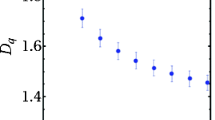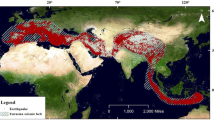Abstract
The variation of temporal fractal dimension D2 (t) value may be well applied for understanding the future large earthquakes. In this present analysis the time series of inter-occurrence of earthquakes of consecutive hundred events window in Himalayan region is analyzed. We observed the variation in D2 (t) values in the range of 0.19 to 0.68 indicating the variation of clustering of events with respect to time. The multifractal nature of earthquakes is also investigated by plotting Dq(t) versus q. The result shows the temporal distribution of earthquakes have multifractal structure of definitive pattern rather than random pattern.
Similar content being viewed by others
References
Avouac, J.P. and Tapponnier, P. (1993) Kinematic model of active deformation in Central Asia.Geophys. Res. Lett., v.20, pp. 895–898.
Bansal, A.R. and Ogata, Y. (2013) A non-stationary epidemic type aftershock sequence model for seismicity prior to the December 26, 2004 M 9.1 Sumatra Andaman Islands mega earthquake. Jour. Geophys. Res., v.118(2), pp.616–629.
Bansal, A.R., Dimri, V.P. and Babu, K.K. (2013) Epidemic type aftershock sequence (ETAS) modeling of northeastern Himalayan seismicity. Jour. Seismol., v. 17(2), pp.255–264.
Bilham, R., Gaur,V.K. and Molnar, P. (2001) Himalayan Seismic Hazard. Science v.293, pp.1442–4.
Bilham, R., Blume, F., Bendick, R. and Gaur, V.K. (1998) Geodetic constraints on the translation and deformation of India: implications for future great Himalayan earthquakes. Curr. Sci., v.74, pp.213–229.
Chamoli, A. and Yadav, R.B.S. (2015) Multifractality in seismic sequences of NWHimalaya. Nat. Hazard, v.77(1), pp.S19–S32.
Enescu, B., Ito, K., Radulian, M., Popescu, M. and Bazacliu, O. (2005) Multifractal and chaotic analysis of Vrancea (Romania) intermediate-depth earthquakes: investigation of the temporal distribution of events. Pure Appld. Geophys.., v.162, pp.249–271.
Gansser, A. (1977) The great suture zone between Himalaya and Tibet: a preliminary account, Colloque International CNRS 268, Ecologie et Géologie de l’ Himalaya, Sciences de la Terre (Edition CNRS, Sèvres-Paris), pp.181–192.
Golitz, C. (1998) Fractal and Chaotic Properties of Earthquakes. Springer, Berlin, 189p.
Guillot, S., Maheo, G., De Sigoyer, J., Hattori, K.H., and Pecher, A. (2008) Tethyan and Indian subduction viewed from the Himalayan high-to ultrahigh-pressure metamorphic rocks. Tectonophysics, v.451,pp.225–241.
Hanks, T.C. (1992) Small earthquakes, tectonic forces. Science, v.256, pp.1430–1432.
Heim, A. and Gansser, A. (1939) Central Himalaya: Geological observations of the Swiss expedition, 1936. Mem. Swiss Soc. Nat. Sci., v.73, pp.245.
Hirata, T. and Imoto, M. (1991) Multifractal analysis of spatial distributions of microearthquake in the Kanto Region. Geophys. Jour. Internat., v.107, pp.155–162.
Kagan, Y.Y. and Jackson, D.D. (1991) Long-term earthquake clustering. Geophys. Jour. Internat., v.104, pp.117–133.
Khattri, K.N. and Tyagi, A.K. (1983) Seismicity patterns in the Himalayan plate boundary and identification of areas of high seismic potential. Tectonophysics, v.96, pp.281–297.
Kurths, J. and Herzel, H. (1987) An attractor in a solar time series. Physica, v.25D, pp.165-172.
Lavé, J. and Avouac, J.P. (2000) Active folding of fluvial terraces across the Siwaliks Hills, Himalayas of central Nepal. Jour. Geophy. Res., v.105 (B3), pp.5735–5770.
Le Fort, P. (1975) Himalayas, the collided range: present knowledge of the continental arc. Amer. Jour. Sci., v.275 (A), pp.1–44.
Lee, H.K. (1995) Fractal clustering of fault activity in California. Geology, v.23, pp. 377–380.
Li, Q and Xu, G.M. (2012) Characteristic Variation of Local Scaling Property before Puer M6.4 Earthquake in China: The Presence of a New Pattern of Nonlinear Behavior of Seismicity. Phy. Solid Earth, v.48(2), pp.155–161.
Long, S., Mc Quarrie, N., Tobgay, T. and Grujic, D. (2011) Geometry and crustal shortening of the Himalayan fold-thrust belt, eastern and central Bhutan. Geol. Soc. Amer. Bull., v.123, (7/8), pp.1427–1447.
Marsan, D. (2005) The role of small earthquakes in redistributing crustal elastic stress. Geophy. Jour. Internat. v.163, pp.141–151.
Matcharashvili, T., Chelidze, T. and Javakhisvili, Z. (2000) Nonlinear analysis of magnitude and inter-event time interval sequences for earthquakes of the Caucasian region. Non-linear Proc. Geophys., v.7, pp.9–19.
Matcharashvili, T., Chelidze, T., Javakhisvili, Z. and Ghlonti, E. (2002) Detecting differences in temporal distribution of small earthquakes before and after large events. Comp. Geosci., v.28, pp.693–700.
Minster, J.B. and Jordan, T.H. (1978) Present day plate motion. Jour. Geophys. Res. v.83, pp.5331–5354.
Molnar, P. (1990) A review of the seismicity and the rates of active under-thrusting and deformation at the Himalaya. Jour. Him. Geol., v.1, pp.131–154.
Nakata, T. (1972) Geomorphic History and Crustal Movements of the Foothill of the Himalayas. Science Reports, Tohoku University, 7th Series. Geography v.22, pp.39–177.
Nakata, T. (1989) Active faults of the Himalayas of India and Nepal. Geol. Soc. Amer. Spec. Paper, v.232, pp.243–264.
Okubo, P.G. and Aki, K. (1987) Fractal geometry in San Andreas fault system. Jour. Geophy. Res., v.92, pp.345–355.
Papadopoulos, G. A. and Voidomatis, P.H. (1987) Evidence for periodic seismicity in the Inner Aegean seismic zone. Pure Appld. Geophys., v.125, pp.613–628
Powers, P.M., Lillie, R.J. and Yeats, R.S. (1998) Structure and shortening of the Kangra and Dehradun reentrants, sub-Himalaya, India. Geol. Soc. Amer. Bull., v.110 (8), pp.1010–1027.
Powell, C.M. and Conaghan, P.J. (1973) Plate tectonics and the Himalayas. Earth Planet. Sci. Lett., v.20, pp.1–12.
Roy, P.N.S. and Padhi, A. (2007) Multifractal analysis of earthquakes in the southeastern Iran-Bam region. Pure Appld. Geophys., v.167, pp.2271–2290.
Roy, P.N.S. and Mondal, S.K. (2012a) Multifractal analysis of earthquakes in Kumaun Himalaya and its surrounding region. Jour. Earth System Sci., v.121(4), pp.1033–1047.
Roy, P.N.S. and Mondal, S.K. (2012b) Seismic Hazards Assessment of Kumaun Himalaya and adjacent region. Na. Haz. v.64, pp. 283–297
Smalley, R.F.J.R., Chatelan, J.-L., Turcotte, D.L. and Prevot, R. (1987) A fractal approach to the clustering of earthquakes: application to the seismicity of the New Hebrides. Bull. Seis. Soc. Amer., v.77, pp.1368–1381.
Sunmonu, L.A., Dimri,V.P., Prakash, M.R. and Bansal, R. (2001) Multifractal approach to the time series of m=7.0 earthquake in Himalayan region and its vicinity during 1895-1995. Jour. Geol. Soc. India v.58, pp.163–169.
Tang, Yi-Jiun, Chang, Young-Fo, Liou, Tai-Sheng, Chen, Chienchih and Wu, Yih-Min (2012) Evolution of the temporal multifractal scaling properties of the Chiayi earthquake (ML=6.4), Taiwan. Tectonophysics v.546-547, pp.1–9.
Telesca, L., Cuomo, V., Lanfredi, M., Lapenna,V. and Macchiato, M. (1999) Investigating clustering structures in timeoccurrence sequences of seismic events observed in the Irpinia–Basilicata Region (Southern Italy). Fractals v.7, pp. 221–234.
Telesca, L., Lapenna,V. and Macchiato, M. (2003a) Investigating the time-clustering properties in seismicity of Umberia-Marche region (Central Italy). Chaos Soliton Fractals, v.18(2), pp.202–217, doi:10.1016/S0960-0779(02)00654-9
Telesca, L., Lapenna, V. and Macchiato, M. (2003b) “Spatial variability of the time-correlated behavior in Italian Seismicity”, Earth Plan. Sci. Lett. v. 212(3-4), pp. 279–290, doi:10.1016/S0012-821X(03)00286-3
Telesca, L. and Lapenna, V. (2006) Measuring multifractality in seismic sequences. Tectonophysics v.423, pp.115–123.
Telesca, L., Balasco, M. and Lapenna, V. (2007) Investigating the time correlation properties in self-potential signals recorded in a seismic area of Irpinia, southern Italy. Chaos Soliton Fractals, v.32, pp.199–211.
Teotia, S.S. and Kumar, D. (2011) Role of multifractal analysis in understanding the preparation zone for large size earthquake in the North-Western Himalaya region. Non-linear Proc. Geophy. v.18, pp.111–118.
Turcotte, D.L. (1989) Fractal in geology and geophysics. Pure Appld. Geophys., v.131, pp.171–196
Wang, J.H. (1996) Multifractal measures of time series of Ms = 7 earthquakes in Taiwan. Jour. Geol. Soc. China, v.39, pp.117–123
Wang, J.-H. and Lee, C.-W. (1997) Multifractal measures of time series of earthquakes. Jour. Phy. Earth, v.45, pp.331–345.
Wang, J.H and Lee, C.W. (1995) Fractal characterization of an earthquake sequence. Physica A v.221, pp.152–158
Wesnousky, S.G., Kumar, S., Mohindra, R. and Thakur, V.C. (1999) Uplift and convergence along the Himalayan Frontal Thrust of India. Tectonics, v.18(6), pp.967–976.
Yeats, R.S. and Thakur, V.C. (1998) Reassessment of Earthquake hazard based on a fault-bend fold model of the Himalayan plate-boundary fault. Curr. Sci., v.74, pp.230–233.
Yin, A. and Harrison, T.M. (2000) Geologic evolution of the Himalayan-Tibetan orogeny.Ann. Rev. Earth Planet. Sci., v.28, pp.211–280.
Yin, A. (2006) Cenozoic tectonic evolution of the Himalayan orogen as constrained by along-strike variation of structural geometry, exhumation history, and foreland sedimentation. Earth Sci. Rev., v.76, pp.1–131.
Zamani, A. and Agh-Atabai, M. (2009) Temporal characteristics of seismicity in the Alborz and Zagros regions of Iran, using a multifractal approach. Jour. Geodyn., v.47, pp.271–279.
Author information
Authors and Affiliations
Corresponding author
Rights and permissions
About this article
Cite this article
Mondal, S.K., Roy, P.N.S. Temporal multifractal pattern of seismicity in northwest Himalayan region. J Geol Soc India 88, 569–575 (2016). https://doi.org/10.1007/s12594-016-0522-6
Received:
Accepted:
Published:
Issue Date:
DOI: https://doi.org/10.1007/s12594-016-0522-6




